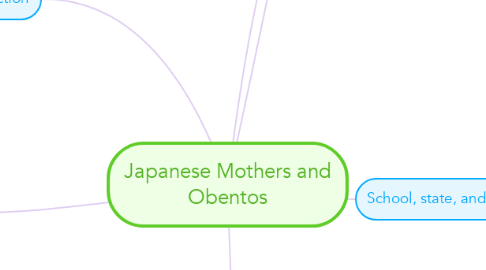
1. Cultural ritual and state ideology
1.1. Not only are the worlds we inhabit symbolically constructed, but also the constructions of our cultural symbols are endowed with, or have the potential for power.
1.2. The fact that culture is not necessarily innocent, and power not necessarily transparent, has been revealed by much theoretical work conducted both inside and outside the discipline of anthropology.
1.2.1. SA- which is power that the state wields and manages primarily through the threat of force.
1.3. Contrasted with this is a second structure of power- ISA.
1.3.1. These are institutions which have some overt function other than a political and or administrative one.
1.4. While both structures of power operate simultaneosuly and complementarily, it is the ISA, which in capitalist societies is the more influential of the two.
2. Introduction
2.1. Food in obento is an everyday practice of Japanese life.
2.2. She argues that the obento is invested with a gendered state ideology. Overseen by the authorities of the nursery school, an institution which is linked to, if not directly monitored by the state, the practice of the obento situates the producer as a woman and mother, and the consumer, as a child of a mother and a student of a school.
3. Mothering as gendered ideological state apparatus
3.1. The rituals surrounding the obento consumption in the school situate with ideological meanings the obento transmits to the childs.
3.2. The making of the obento is, a double edged sword for women, By relishing its creation, a woman is ensconcing herself in the ritualization and subjectivity of being a mother in Japan.
3.3. The message is also that it is women who are not only sustaining a child through food but carrying the ideological support of the culture that this food embeds.
4. Japanese food as cultural myth
4.1. In Japan, much attention is focused on the obento, investing it with a significance far beyond that of the merely pragmatic, functional one of sustaining a child with nutritional foodstuffs.
4.2. The key element is appearance.
4.2.1. Food must be organized, re-organized, arranged, re-arranged, stylized and re stylized to appear in a design that is visually attractive.
4.3. Donald Richie has pointed out that presentational style is the guiding principle by which food is prepared in Japan.
4.3.1. Visually, food substances are presented according to a structural principle not only of segmentation but also opposition.
4.4. The naturalization of food is rendered through two main devices.
4.4.1. One is by constantly hinting at and appropriating the nature that comes from outside. The other is to some degree the inverse of the first, is to accentuate and perfect the preparation process to such an extent that the food appears not only to be natural, but more nearly perfect than nature without human intervention.
4.5. Embedded within this insistence on eating Japanse food, thereby reconfirming one as a member of the culture, are the principles by which Japanse food is customarily prepared.
5. School, state, and subjectivity
5.1. The rituals and routines surrounding obentos present as it were, a third order, manipulation. This order is a use of currency already established- one that has already appropriated a langugae of ultility to express and implant cultural behaviors.
5.2. The latter of equation depends on two factors: the convergence or divergence of different interests in what is desired as subjectivities, and the power any particular interest, including that of the state, has in exterting its desires for subjects on or through the system of education.
5.3. The role of the state in Japanese education is not limited, however, to such extensive but codified authorities granted to the ministry of education.
5.3.1. School attendance is itself based on single criterion: a system of entrance exams which determines entrance selection and it is to this end- preparation for exams.
6. Nursery school and ideological appropriation of the obento
6.1. While the state has no mandate over nursery school attendance, its influence is nevertheless significant.
6.1.1. First, authority over how the yochien is run is in the hands of the Ministry of Education. Second, most parents and teachers see the yochien as the first step to the system of compulsory education that starts in the first grade and is closely controlled by Monusho.
6.2. The entry into nursery school marks a transition both away from home and into the real world.
6.2.1. The obento is filled with the meaning of mother and home in a number of ways. The first is by sheer labor.
6.3. Effort alone does not produce a successful obento.
6.3.1. The exhortation to consume ones entire obento is articulated and enforced by the nuersery school teacher.
